HARRIS TR-417-A2 Cellular Phone User Manual exhibit 8
HARRIS CORPORATION Cellular Phone exhibit 8
HARRIS >
exhibit 8

LZT 123 4598/12 R1
THIS MODEL PHONE MEETS THE GOVERNMENT’S
REQUIREMENTS FOR EXPOSURE TO RADIO WAVES.
Your wireless phone is a radio transmitter and receiver. It is designed and
manufactured not to exceed the limits for exposure to radio frequency
(RF) energy set by the Federal Communications Commission (FCC) of
the U.S. Government. These limits are part of comprehensive guidelines
and establish permitted levels of RF energy for the general population.
The guidelines are based on standards that were developed by indepen-
dent scientific organizations through periodic and thorough evaluation
of scientific studies. The standards include a substantial safety margin
designed to assure the safety of all persons, regardless of age and health.
The exposure standard for wireless mobile phones employs a unit of
measurement known as the Specific Absorption Rate, or SAR. The SAR
limit set by the FCC is 1.6W/kg.* Tests for SAR are conducted using
standard operating positions accepted by the FCC with the phone trans-
mitting at its highest certified power level in all tested frequency bands.
Although the SAR is determined at the highest certified power level, the
actual SAR level of the phone while operating can be well below the
maximum value. This is because the phone is designed to operate at
multiple power levels so as to use only the power required to reach the
network. In general, the closer you are to a wireless base station antenna,
the lower the power output.
Before a phone model is available for sale to the public, it must be tested
and certified to the FCC that it does not exceed the limit established by
the government-adopted requirement for safe exposure. The tests are
performed in positions and locations (i.e., at the ear and worn on the
body) as required by the FCC for each model. The highest SAR value as
reported to the FCC for this model phone when tested for use at the ear
is 1.35 W/kg and when worn on the body is .83 W/kg. Body worn mea-
surements are made while the phone is in use and worn on the body
with an Ericsson accessory. The design and composition of an accessory
can affect the body worn SAR levels for the phone. Ericsson has not
measured, and makes no representation about the body worn SAR levels
when the phone is used with non-Ericsson accessories.
The FCC has granted an Equipment Authorization for this model
phone with all reported SAR levels evaluated as in compliance with the
FCC RF exposure guidelines. While there may be differences between
the SAR levels of various phones, all mobiles granted a FCC equipment
authorization meet the government requirement for safe exposure.
SAR information on this model phone is on file with the FCC and can
be found under the Display Grant section of http://www.fcc.gov/oet/
fccid after searching on FCC ID AXATR-417-A2.
Additional information on Specific Absorption Rates (SAR) can be
found on the Cellular Telecommunications & Internet Association
(CTIA) web-site at http://www.phonefacts.net/.
___________________________________
* In the United States and Canada, the SAR limit for mobile phones
used by the public is 1.6 watts/kilogram (W/kg) averaged over one
gram of tissue. The standard incorporates a substantial margin of
safety to give additional protection for the public and to account for
any variations in measurements.
Important Information
Mobile Phone
T60d
User’s Guide
PRELIMINARY

Para obtener una copia en español de esta Guía del Usuario, visite nuestra página Web en
www.ericsson.com/phones o, si se encuentra en Estados Unidos, también puede llamar al 1-800-374-2776.
Register your new phone, purchase Ericsson original accessories,
and see the latest in products by visiting us at: www.ericsson.com/phones
8/01 PBM
This manual is published by Ericsson Inc., without any warranty. Improvements and changes
to this manual necessitated by typographical errors, inaccuracies of current information, or improvements
to programs and/or equipment, may be made by Ericsson Inc., at any time and without notice.
Such changes will, however, be incorporated into new editions of this manual.
“Ericsson”, “Ericsson ” and “ERICSSON ORIGINAL ACCESSORIES” are each
registered U.S. Trademarks owned by Telefonaktiebolaget L M Ericsson of Sweden.
“Microsoft”, “Windows” and the design plus words “Microsoft Windows” are each either registered
and/or pending U.S. Trademarks owned by Microsoft Corporation of Redmond, Washington, U.S.A.
Trademarks referred to herein are trademarks of their respective companies.
T9 Text Input is licensed under one or more of the following: U.S. Pat. Nos. 5,818,437, 5,953,541, 5,187,480,
5,945,928, and 6,011,554; Canadian Pat. No. 1,331,057; United Kingdom Pat. No.2238414B; Hong Kong
Standard Pat. No. HK0940329; Republic of Singapore Pat. No. 51383; Euro.Pat. No. 0 842 463 (96927260.8)
DE/DK, FI, FR, IT,NL,PT.ES,SE,GB; and additional patents are pending worldwide.
© 2001, Ericsson Inc. All rights reserved.
Publication Number: AE/LZT 123 6623 P1B
Printed in USA
Table of Contents
About this User’s Guide.............................. 9
Getting Started ........................................... 11
Voice Operation ......................................... 21
Menus ........................................................ 25
Using the Phonebook ................................. 41
Voice Command......................................... 53
Text Input .................................................. 67
Using the Calendar ..................................... 71
Making Data and Fax Calls......................... 75

1
Guidelines for Safe and Efficient Use
Since its introduction in the mid 1980s, the mobile
phone has been one of the most exciting and innovative
products ever developed. Your phone can help you to
stay in touch with your office, your home, emergency
services and others.
Safety
Exposure to Radio Frequency Signals
Your wireless handheld portable telephone is a low power
radio transmitter and receiver. When it is ON, it receives
and also sends out radio frequency (RF) signals.
In August, 1996, the Federal Communications
Commission (FCC) adopted RF exposure guidelines
with safety levels for handheld wireless phones. Those
guidelines are consistent with the safety standards
previously set by both US and international standards
bodies:
•ANSI C95.1 (1992)*
•NCRP Report 86 (1986)*
•ICNIRP (1996)*
Those standards were based on comprehensive and
periodic evaluations of the relevant scientific literature.
For example, over 120 scientists, engineers, and
physicians from universities, government health agencies,
and industry reviewed the available body of research to
develop the ANSI Standard (C95.1).
The design of your phone complies with the FCC
guidelines (and those standards).
* American National Standards Institute: National Council
on Radiation Protection and Measurements; International
Commission on Non-Ionizing Radiation Protection.
Antenna Care
Use only the supplied or an approved replacement
antenna. Unauthorized antennas, modifications, or
attachments could damage the phone and may violate
FCC regulations.

2
Phone Operation
NORMAL POSITION: Hold the phone as you would
any other telephone with the antenna pointed up and
over your shoulder.
TIPS ON EFFICIENT OPERATION: For your phone
to operate most efficiently:
•Extend your antenna fully (where applicable).
•Do not touch the antenna unnecessarily when the
phone is in use. Contact with the antenna affects call
quality and may cause the phone to operate at a
higher power level than otherwise needed.
Driving
Check the laws and regulations on the use of wireless
telephones in the areas where you drive. Always obey
them. Also, if using your phone while driving, please:
•Give full attention to driving - driving safely is your
first responsibility.
•Use handsfree operation, if available.
•Pull off the road and park before making or answer-
ing a call if driving conditions so require.
In addition, Ericsson suggests the following safe driving
tips if you are using your phone while driving:
•Get to know your wireless phone and its features
such as speed dial and redial.
•Position your wireless phone within
easy reach.
•Suspend conversations during hazard-
ous driving conditions or situations.
•Do not take notes or look up phone
numbers while driving.
•Dial sensibly and assess the traffic; if possible, place
calls when you are not moving or before pulling into
traffic.
•Do not engage in stressful or emotional conversa-
tions that may be distracting.
•Use your wireless phone to call for help.
•Use your wireless phone to help others in emergen-
cies.
3
•Call roadside assistance or a special wireless non-
emergency assistance number when necessary.
Electronic Devices
Most modern electronic equipment is shielded from RF
signals. However, certain electronic equipment may not
be shielded against RF signals from your wireless phone.
Pacemakers
The Health Industry Manufacturers Association
recommends that a minimum separation of six (6”)
inches be maintained between a handheld wireless phone
and a pacemaker to avoid potential interference with the
pacemaker. These recommendations are consistent with
the independent research by and recommendations of
Wireless Technology Research.
Persons with pacemakers:
•Should ALWAYS keep the phone more than six
inches from their pacemaker when the phone is
turned ON.
•Should not carry the phone in a breast pocket.
•Should use the ear opposite the pacemaker to mini-
mize the potential for interference.
•If you have any reason to suspect that interference is
taking place, turn your phone OFF immediately.
Hearing Aids
Some digital wireless phones may interfere with some
hearing aids. In the event of such interference, you may
want to consult your service provider (or call the
customer service line to discuss alternatives).
Other Medical Devices
If you use any other personal medical device, consult the
manufacturer of your device to determine if it is
adequately shielded from external RF energy. Your
physician may be able to assist you in obtaining this
information.
Turn your phone OFF in health care facilities when any
regulations posted in these areas instruct you to do so.
Hospitals or health care facilities may be using
equipment that could be sensitive to external RF energy.
Vehicles
RF signals may affect improperly installed or
inadequately shielded electronic systems in motor
vehicles. Check with the manufacturer or its

4
representative regarding your vehicle. You should also
consult the manufacturer of any equipment that has been
added to your vehicle.
Posted Facilities
Turn your phone OFF in any facility where posted
notices so require.
Aircraft
FCC regulations prohibit using your phone while in the
air. Switch OFF your phone before boarding an aircraft.
Blasting Areas
To avoid interfering with blasting operations, turn your
phone OFF when in a “blasting area” or in areas posted:
“Turn off two-way radio.” Obey all signs and
instructions.
Potentially Explosive Atmospheres
Turn your phone OFF when in any area with a
potentially explosive atmosphere and obey all signs and
instructions. Sparks in such areas could cause an
explosion or fire resulting in bodily injury or even death.
Areas with a potentially explosive atmosphere are often
but not always clearly marked. They include fueling areas
such as gasoline stations; below deck on boats; fuel or
chemical transfer or storage facilities; vehicles using
liquefied petroleum gas (such as propane or butane);
areas where the air contains chemicals or particles, such
as grain, dust, or metal powders; and any other area
where you would normally be advised to turn off your
vehicle engine.
For Vehicles Equipped with an Air Bag
An air bag inflates with great force. DO NOT place
objects, including both installed or portable wireless
equipment, in the area over the air bag or in the air bag
deployment area. If in-vehicle wireless equipment is
improperly installed and the air bag inflates, serious
bodily injury could result.
Product Care and Operation
This device complies with Part 15 of the FCC Rules.
Operation is subject to the following two conditions: 1)
5
This device may not cause harmful interference, and 2)
This device must accept any interference received,
including interference that may cause undesired
operation.
Ericsson suggests you read and observe the following for
safe care and operation of your phone:
•Do not allow children to play with your phone or its
accessories. They could hurt themselves or others, or
could accidentally damage the phone or accessory.
Your phone or its accessories may contain small parts
that could be detached and create a choking hazard.
•Do not expose your mobile phone to moisture or
extreme temperatures.
•Only Ericsson original accessories are recommended.
Failure to use them may result in loss of performance
or product damage, and will void the warranty.
•Do not attempt to disassemble the product. Doing
so will void warranty. This product does not contain
consumer serviceable components. Service should
only be performed by Authorized Service Centers.
•Do not allow objects to fall on, or liquids to spill on
products.
•Connect AC (power supply) only to designated
power sources as marked on the product.
•To reduce risk of damage, remove the electrical cord
from the outlet by pulling the AC adapter at the out-
let rather than the cord.
•Make sure the electric cord is located so that it will
not be stepped on, tripped over, or otherwise sub-
jected to damage or stress.
•To reduce risk of electric shock, unplug the unit
from the power source before attempting any clean-
ing. Once unplugged, use a soft cloth lightly damp-
ened with water for cleaning.
•DANGER - Never alter the AC cord or plug. If the
plug will not fit into the outlet, have a proper outlet
installed by a qualified electrician. Improper connec-
tion can result in risk of electric shock.
•Don’t twist the antenna. Excess twisting will damage
the antenna.
•Before a phone model is available for sale to the pub-
lic, it must be tested and certified to the FCC that it
does not exceed the limit established by the govern-

6
ment-adopted requirement for safe exposure. The
tests are performed in positions and locations (i.e., at
the ear and worn on the body) as required by the
FCC for each model. Body worn measurements are
made while the phone is in use and worn on the
body with an Ericsson accessory. The design and
composition of an accessory can affect the body
worn Specific Absorption Rate (SAR) levels for the
phone. Ericsson has not measured, and makes no
representation about the body worn SAR levels when
the phone is used with non-Ericsson accessories.
Battery Information
New Batteries
The battery packaged with your phone is not fully
charged. For maximum battery capacity, use your charger
to condition the battery.
Recycling Your Battery
Your phone manufacturer is a member of the
Rechargeable Battery Recycling Corporation (RBRC), a
non-profit service organization designed to assist in the
recycling of rechargeable batteries. Many areas require
the recycling of rechargeable batteries. In the U.S., call 1-
800-822-8837 to find out how to recycle your battery.
Outside the U.S., contact your local retailer for recycling
instructions.
Battery Use and Care
Battery use and care varies slightly depending upon
which type of battery your phone is equipped with:
Nickel Metal Hydride (NiMH) or Lithium Ion (LiIon).
Nickel Metal Hydride (NiMH) Batteries
A rechargeable battery has a long service life if treated
properly. A new battery, or one that has not been used for
a long period of time, should be conditioned before
using your phone. Avoid recharging a fully-charged or
almost fully-charged battery. If your phone shuts off due
to low battery power, you should charge the battery
within 24 hours for the battery to reach full capacity.
7
•Do not leave your battery where it may be subjected
to extremely hot or cold temperatures. This could
reduce the battery’s capacity.
•Do not let the metal contacts on the battery touch
another metal object such as keys in your pocket.
This could short-circuit and damage the battery.
•Do not attempt to take a battery apart.
•Do not expose a battery to open flame. This could
cause the battery to explode.
•Turn your phone OFF before removing the battery.
•Use only the AC/DC adapter supplied with your
battery charger. Using a different adapter could be
dangerous and will void your phone warranty.
•Never charge a battery when the ambient room tem-
perature is below 50° F (10°C) or above 105°F
(40°C).
•Keep away from children and do not allow the bat-
tery to be placed in their mouth. Battery electrolytes
may be toxic if swallowed. Avoid battery electrolyte
contact with your skin and eyes.
Lithium Ion (Li-Ion) Batteries
Follow these battery use instructions if your phone is
equipped with a rechargeable Lithium-Ion (Li-Ion)
battery pack.
WARNIN G! This battery may explode and cause
potential injury if exposed to or disposed of in a fire.
•Do Not expose the battery to temperatures above
140° F (60°C), such as in a car parked in the sun or
on a hot day.
•Do Not short-circuit the battery’s metal contacts
with metallic objects, such as keys in your pocket, as
it may damage the battery.
•Do Not disassemble the battery.
•Use only Ericsson Original accessory chargers
(including handsfree units that act as a charger) and
the AC/DC adapter supplied with your battery
charger. Use on a non-Ericsson Original accessory
may be hazardous and damage from such use will
void your phone warranty.
8
•Charging the battery at room temperatures below
41°F (5°C) or above 113°F (45°C) may degrade bat-
tery performance and could be hazardous.
•Keep away from children and do not allow the bat-
tery to be placed in their mouth. Battery electrolytes
may be toxic if swallowed. Avoid battery electrolyte
contact with your skin and eyes.
•Do Not use a damaged battery or charger.
•Turn off your phone before removing the battery.
•Do Not expose the battery to water or other liquids.
•Avoid dropping the battery while removing it from
the phone.
•Avoid puncturing or crushing the battery.
•Only use the battery for its intended purpose.
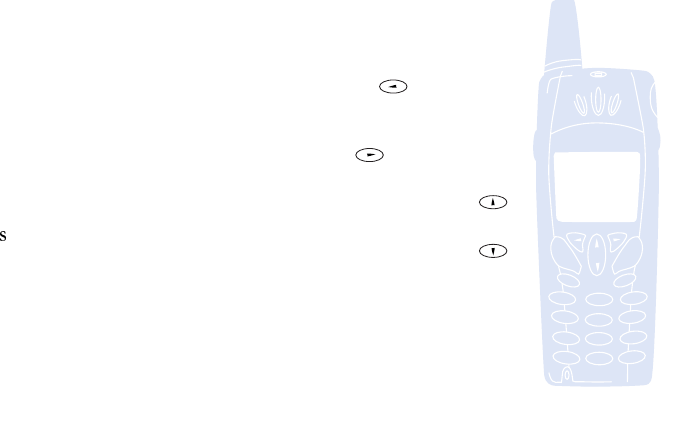
About this User’s Guide 9
About this User’s Guide
•A Menu Diagram is located on the inside front cover
of this User’s Guide. This is a quick overview of the
menus in the T60d.
•A Quick Reference Card is located on the inside
back cover. Tear along the perforations to carry this
handy card with you.
•Menu names are shown in the following
typeface: MENUS.
•Submenu names are shown in the following type-
face: ubmenu Names.
•Key names are shown in the following typeface:
CLR.
•Text that is seen in the phone’s display is shown in
the following typeface: Displays.
•When this guide instructs you to press a key, press
and release the key.
•When this guide instructs you to press and hold a
key, press and hold the key for one to two seconds.
•Tilt the joystick to the left
when you see this sym-
bol.
•Tilt the joystick to the right
when you see this symbol.
•Tilt the joystick up when
you see this symbol.
•Tilt the joystick down when
you see this symbol.
•Depress the center push key
when you see this symbol (
).
10 About this User’s Guide
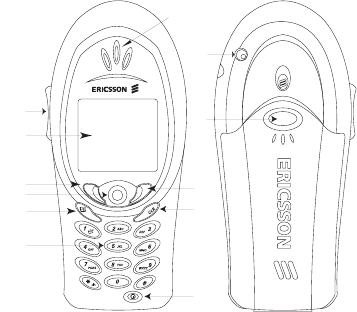
Getting Started 11
Getting Started
1 Earpiece
2 Side volume keys
3 Display
4 Left softkey
5 Joystick
6 Options key
7 Keypad
8 Power On/Off key
9 CLR key
10 Right softkey
11 Battery release button
12 External antenna connector
1
2
3
5
6
7
8
9
10
4
11
12

12 Getting Started
Assembly
Assembling your phone in four easy steps:
1 Remove the Back Cover
2 Attach the Battery
3 Replace the Back Cover
4 Charge the Battery
Getting Started 13
Step 1: Remove the Back Cover
14 Getting Started

Getting Started 15
1 Press down on the button to release the back cover.
2 Slide the back cover off.
Step 2: Attach the Battery
1 Locate the connector at the
end of the blue, red, and
black wires. Insert the plug
as shown in the diagram.
Note! The cable will only
properly fit one way
- do not force it.
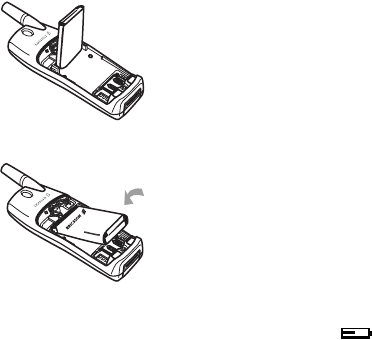
16 Getting Started
Note! Remove the battery by removing the back panel as
described above. Raise the battery and slide it out
of the hinges one side at a time.
Step 3: Replace Back Cover
1 Insert the cover, bottom first, on the back of the
phone.
2 The back cover will snap into place.
Step 4: Charge the Battery
When to Charge
Note! For detailed information on safely handling your
battery, see “Battery Information” on page 4.
Your phone comes with a Lithium Ion (LiIon) battery.
The battery is not charged when you buy your phone,
but there may be enough power to switch the phone on.
You should fully charge the battery before use. It is safe to
make and receive calls while your phone is charging. You
should not need to remove your battery after it is
installed. Your battery can be charged whenever you wish
without affecting its performance. You can also charge
the battery when the phone is off.
The battery meter icon ( )on your standby screen
indicates how much remaining strength your battery has.
Tip! If you have an Ericsson-approved battery, you can
check the remaining talk and standby times in the
STATUS menu using the side volume keys when in
2 Holding the battery at a
perpendicular angle, slip the
left side of the battery into
the hinge. Snap the right
side in.
3 Lower the battery until it
lays flat.

Getting Started 17
standby mode. The total remaining standby and
talk time depends on the type of battery you use
and your position in the network. Please note that
these times are approximate and you may have
20% less time than is shown in the display.
Note! The phone turns itself off when the battery can no
longer power it satisfactorily.
Charging Indicators
•Attention Battery Low (with a short beep)
Phone needs charging.
•Optimized Charging (meter pulses continuously)
Your phone is currently charging an Ericsson-
approved battery. Your battery is fully charged when
the meter stops pulsing.
•Charging Battery (meter pulses continuously)
Your phone is currently charging a non-Ericsson
approved battery (charges very slowly). Your battery
is fully charged when the meter stops pulsing.
Charging
1 Make sure that the battery is attached to the phone.
2 Connect the charger to the electrical outlet.
3 Connect the charger to the phone as shown in the
picture. The flash symbol on the plug must face
upwards.
Note! The main electri-
cal plug may look
different depend-
ing on the electrical
socket in your
country. The plug may not be used for products
other than Ericsson chargers.
Disconnecting the Charger
Move the plug connected to the phone
upwards to remove it, as shown in the
picture.
Note! Never use your phone with the front cover
removed.
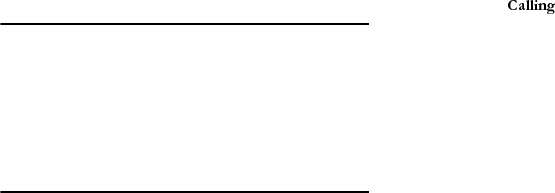
18 Getting Started
Turning Your Phone On and Off
Turn your phone On by pressing and holding the power
key until your phone turns on. The phone will beep
(unless silent mode is activated). Turn your phone Off by
pressing and holding the power key until your phone
turns off.
Making and Receiving Calls
See “Voice Calls” on page 16 for more information about
making and receiving calls.
Making Calls
1 Press the numeric keys to enter the phone number
you want to call. The number is shown in the dis-
play.
Note! You can press CLR to erase one or more digits in
the display, or press and hold CLR to erase all dig-
its.
2 Press
YES. , along with the number you are
dialing, is shown in the display while your phone
accesses the wireless network.
3 When the call is connected, a call timer is shown in
your display. The phone number that you dialed
will remain on your screen.
4 To end the call, press NO.
Making Emergency Calls
Enter the emergency number stored in your phone and
press YES.
Note! Keypad lock prohibits emergency number access
until unlocked.
Making International Calls
1 Diall 011, the country code, the area code (without
the leading zero) and the phone number.
2 Press
YES.
Note! Check with your service provider if you are having
problems making international calls.
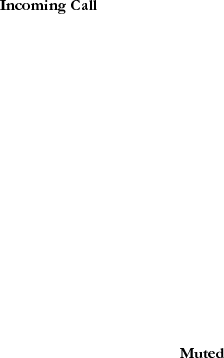
Getting Started 19
Receiving Calls
When your phone receives a call, the ringer sounds,
appears in the display, and the display
and keypad backlight illuminate. You can temporarily
silence the ringer by pressing the QUIET soft key or the
upper or lower side keys, and still answer the call by
pressing YES. If you have Caller Number Identification
(Caller ID) service from your service provider, the caller’s
phone number is shown in the display. The caller’s name
will also appear if the phone number is found in your
phonebook.
Changing the Earpiece Volume
During a call, you can change the earpiece volume by
pushing the upper side volume key.
•Push up to increase the volume.
•Push down to decrease the volume.
Muting the Microphone
During a call, you can turn off the microphone.
•Press and hold CLR until appears in the dis-
play.
•Press and hold CLR again to resume the conversation.
Tip! Instead of pressing and holding CLR, you can put
the call on hold by pressing YES.
20 Getting Started

Voice Operation 21
Voice Operation
In Voice Operation, you can make and receive calls; work
with your voice mail and messages; change your phone’s
voice settings; add, edit, or delete entries from your
phonebook; and send and receive text messages.
Voice Operation Icons
1 New Voice Mail Icon ( ) indicates the number
of voice mail messages that have not been heard.
The icon appears only when you have voice mail
messages waiting. The number, beside the icon, (
shown above) indicates how many voice mail mes-
sages you have.
2 New Text Mail Icon ( ) indicates the number of
text messages that have not been read. The icon
appears only when you have text messages waiting.
The number, beside the icon, ( shown above) indi-
cates how many text messages you have.
3 Browser Alert ( ) indicates that there is new con-
tent in your Inbox (for example, email or stock
quotes).
4 Keypad Lock Icon ( ) indicates that pressing the
keys has no effect. The keypad is locked to prevent
inadvertent key presses. Press and hold * for the
OPTIONS menu to toggle Keypad Lock on and off.
5 Current Time is displayed (if provided by the sys-
tem).
6 Battery Icon ( ) shows the relative strength of
your battery. A full icon indicates a fully-charged
battery. If the phone is connected to external power
1234
5
67/8
910
11
12
13
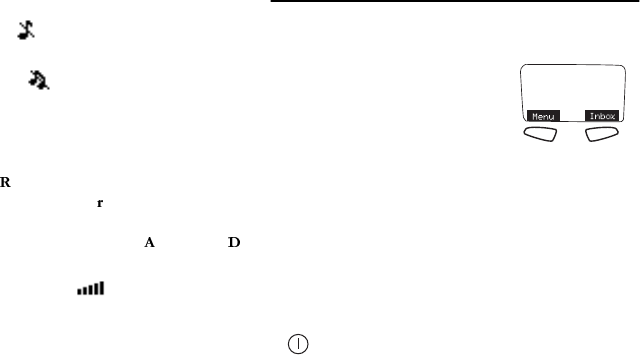
22 Voice Operation
and the battery is charging, the battery icon will
continuously fill and empty.
7 Ringer Off ( ) Icon indicates that your phone
will not make ring sounds.
8 Phone Silent ( ) Icon indicates that your phone
will not make any sounds. Press and hold * for the
OPTIONS menu to toggle Phone Silent on and off.
9 Roaming Preferred icon indicates if you are roam-
ing in a preferred network. If a preferred network is
found, an will appear. If the roaming network is
not preferred, a lowercase will appear.
10 Analog/Digital Channel Indicator shows whether
the phone is operating in analog ( ) or digital ( )
mode.
11 Signal Strength Icon ( ) shows the relative sig-
nal strength from the wireless system. More bars
indicate a stronger signal (maximum of five bars).
12 Current Date is displayed if provided by the sys-
tem.
13 Banner indicates that the phone is in standby mode
and is ready for use. Your personal banner, or the
network provided information is displayed here.
Key Functions
Soft Keys
Your phone is equipped with
soft keys. The soft keys are
displayed in reverse video (when
selected) on the status bar of
your display. To use the soft key
functions, press the left or right
key that is under the text label on the screen. For
example, press the left key to select Back or press the
right key to select the ????.
Keypad Keys
Press... To
power your phone on and off
.......................

Voice Operation 23
Escape (normal press).
Cancel (long press).
Back up one level in menu system.
CLR Delete numbers and letters from the
display.
Delete an item from a list.
Turn off the microphone during a call.
Press and hold the key.
Set the phone to silent, press and hold the
key from standby.
Push
Button
Select a menu or option.
Accept/Yes/Send (same function as left soft
key).
Shortcut to Menus from standby.
Shortcut to Phonebook from standby.
Press... To
Voicemail access.
Enter *.
Enter a pause (p).
Shift between capital and lower-case
letters.
Enter #.
Enter a stop.
Increase or decrease the volume of the
earpiece or handsfree loudspeaker during a
call.
Reject an incoming call by pushing the key
twice.
Enter the Status menu by pushing the key
once.
Activates voice dialing
Press... To
24 Voice Operation
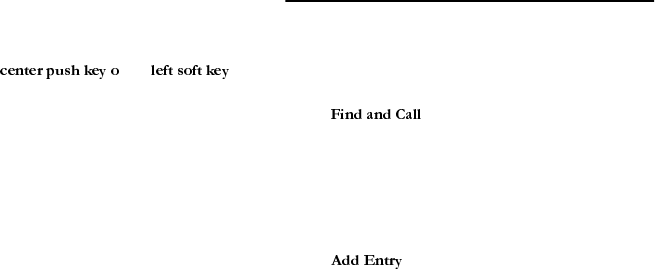
Menus 25
Menus
The main menu has icons that display the top-level
menus. The corresponding title of the selected option is
displayed below the menu tabs when highlighted. Each
menu is represented by an icon. A menu diagram is
located on the inside front cover of this user’s guide.
Accessing Menus
•Press the r the to
choose the menu, function, or setting that is
selected.
•Press the left soft key to go back one level in the
menu structure.
Help Texts
To help you use the menus and functions, your phone
has pop-up help texts that explain the menus. These help
texts are set to On when you buy your phone, but you
can turn them off at any time.
1 Scroll to SETTINGS, YES, Display, YES, Menu Help,
YES.
2 Select On or Off and press YES.
Phonebook Menu
For more information on using the phonebook, see
“Using the Phonebook” on page 41.
Find and Call
The submenu displays phonebook entries
in their location order or in alphabetical order. Select an
entry or type in the position number and press YES to
call.
Find and Send
Add New Contact
The submenu allows you to store a phone
number and an accompanying name in your phonebook.

26 Menus
Find and Edit Contact
The submenu allows you to
change your phonebook entries. These entries are also
listed in their location order.
My Number
The submenu is used to display and switch
between the wireless phone numbers that correspond to
the subscriptions that are programmed into your phone.
Note! If your service provider allows multiple phone
numbers, the submenu allows you
to switch between phone numbers.
Voice Labels
List of all phonebook entries with voice labels. Use this
submenu to manage your voice labels.
Groups
The submenu allows you to organize the
members of your phonebook into categories. Each
category can then have a distinctive ring sound associated
with it and can be used for call screening if your network
supports Caller ID.
Calling Cards
The submenu allows you to store calling
card numbers to use for making long distance calls. The
two options for the submenu are Card
Setup and Set Calling Cards.
Note! You will be prompted to enter your PIN to enter
the submenu. The default PIN is
0000.
Card setup
To set up your calling cards, make sure you have the
Calling Card Access Numbers (numbers provided by
your long distance carrier) and the Verification Numbers
(numbers you must enter to allow the calling card call to
be completed).
When you enter the Card setup submenu, you are
prompted for the following information: Your PIN; the
Name of your calling card; the Access number; the
Dialing delay; Code first or Number first; Verification
number; and Dialing delay again.
Set calling cards
The submenu allows you to select
which calling card to use for a particular call. You can

Menus 27
select a specific calling card by pressing or until the
calling card you want to use is highlighted. If you select
None, you will be prompted during call origination to
select the calling card to which the call will be charged.
Press YES to choose the highlighted selection.
Note! Only cards that have been set up will appear as
options for Default card.
Making a Calling Card Call
1 Enter or recall the phone number you want to
call.
2 Press and hold
YES. The calling card number
and the active calling card are shown in the dis-
play.
3 Release the key after the number has been dis-
played.
If you are using stops between numbers, you must press
YES to send the next sequence of numbers. If you use
pauses, the numbers are sent automatically after the
specified length of time chosen for the dialing delay.
Phonebook Options
Use this submenu to change search order, to delete all
phonebook entries, or to set up shortcuts.
Phonebook Status
This submenu displays internal information.
Messages Menu
For more information on messages, see “Short Message
Service (SMS)” on page 46.
The MESSAGES menu contains choices for specifying and
accessing message services that may be available from
your service provider (for example, text messages and
voice mail).
Check Voice Mail
The submenu allows you to enter
and access your voice mail access number if you have
voice mail service from your service provider. A number
and the voice message icon ( ) appear in the Standby
screen to indicate the number of new unread voice
messages. The maximum number of new voice mail

28 Menus
messages that can be displayed is 99. The submenus are
and
SMS
The SMS submenu contains your inbox as well as the
option to send new messages. You can choose to create
your own short message or use one of the templates, or
canned messages, available in your phone.
Send new
The submenu is used to enter and send a new
text message or an email. To enter letters and symbols in
your message, see “Entering Letters and Symbols” on
page 11.
Note! This option is operator dependent.
Note! If your message approaches the maximum message
length, you will see a character countdown indica-
tor in the upper left corner of the screen.
When you forward a message, you will also forward the
original body of the message. However, when you reply
to a message, you can choose to include the original, use
a canned message, or start with a blank message.
Note! The maximum message length varies according to
service provider.
Once you have entered the text you want included in
your SMS, press YES. You will prompted to enter the
number. You can enter a number or you can press to
choose a name/number from your phonebook or to
choose a group. Press YES to send the message or NO to
save the message as a draft.
Note! You can set delivery parameters, including Mes-
sage receipt and Priority, before a message is sent.
To change these settings see “Message receipt” on
page 19 and “Priority” on page 19. The default
setting for Message receipt is Off and the default
setting for Priority is Normal.
Note! To send a message, you must enter a 10-digit
number (unless Auto Prefix is enabled).
Unsent
The submenu allows you to display a list of
saved draft messages and messages that were not
successfully sent along with a count of the number of
messages currently Unsent. The first few words of each
message, or the subject, is displayed. You can scroll

Menus 29
through the list of messages by using the or key.
The five options for a selected message in the
submenu are Send, Delete, Call Number, Read Next,
and View Error.
Note! This option is operator dependent.
Templates
allows you to use one of 10 editable
templates instead of creating an original message. For
example, a canned message is “I will be ___ late for ___
on ___.” You can edit the canned message text by
scrolling to the blanks in the message using the or
key to quickly fill in the necessary information. The
following list indicates your template options:
•Add new? (Allows you to enter text and save as a new
template)
•I’ll be at ___ until ___.
•I’ll be home at ___.
•I’ll be ___ late for ___.
•OK, I got it.
•Please call me back.
•Please call ___ at ___.
•Please get ___ from ___ by ___.
•Please pick me up from ___ at ___.
•See you later.
•Meeting w/ ___ about ___ at ___ on ___.
Once you have entered the text you want included in
your SMS, press YES. You will prompted to enter the
number. You can enter a number or you can press to
choose a name/number from your phonebook or to
choose a group. Press YES to send the message or NO to
save the message as a draft.
Note! You can set delivery parameters, including Mes-
sage receipt and Priority, before a message is sent.
To change these settings see “Message receipt” on
page 19 and “Priority” on page 19. The default
setting for Message receipt is Off and the default
setting for Priority is Normal.
Note! This option is operator dependent.
Sent Items
The submenu allows you to display and work
with your sent messages. The first few words of each
message, or the subject, is displayed. You can scroll
through the list of messages by using the or key.
The four options for a selected message in the

30 Menus
submenu are Forward, Delete, Call number, Read next,
and Lock/Unlock, Send email (if there is a highlighted
embedded email address), and Go to URL (if there is a
highlighted embedded email address).
Note! This option is operator dependent.
Empty Folders
The submenu allows you to delete all
messages in your Inbox, as well as Unsent and Sent
Messages.
Email Client
Send and receive
Inbox
Compose
Outbox
Drafts
Archive
Messages Options
Options of this submenu include Message Alert, Set
Voicemail Number, and Area Information.
Message Alert
Set VM number
ARea info
Message type
Validity
Delivery Ack
Callback
Enable rep

Menus 31
Memory Used
?
Call Info Menu
The CALL INFO menu allows you to view information
and establish dialing and answering preferences for your
phone (some selections available in this menu are
dependent on your service provider). It also enables you
to view and edit system options and call statistics.
Call list
Press the left softkey from the submenu to view
the last 50 received, missed, and sent calls.
From this list you may view details, call, add the number
to your phonebook, or delete the number
• Press YES. Press YES again to
call the number.
•: Press, and briefly hold, YES.
•: Press BACK.
Icons
One of the following icons will appear next to each
number in the Call List.
Call Timers
You can check the duration of your Last Call, Outgoing
Calls, Incoming Calls, and the Total Time. You also have
the option to check the number of sent SMS messages.
Indicates a missed call in your Call list.
Indicates an incoming call in your Call list.
Indicates an outgoing call in your Call list.
?

32 Menus
Use the Clear Info submenu to clear the timers and
counters.
Last call
Tot a l time
Outgoing time
Incoming time
SMS Counter
Clear info
Minute minder
Call Info Options
Clear call list
call list active
Ongoing Call Menu
Activate scratchpad
Hold Call
Switch call
Retrieve call
Release all
Call info
Settings Menu
Sounds
Ring Volume
The submenu allows you to set the level of
the ring volume. The volumes range from Off to High.
You can change the by moving your joystick
to the right (louden) or to the left (to soften). Press the
left softkey or press the joystick to confirm your
selection.

Menus 33
Increasing Ring
When you select Increasing Ring, the ring volume will
continue to increase until you answer or reject the call.
Vibrating alert
Your phone has a built-in so you can
receive calls or messages silently.
1 Scroll to
SETTINGS, YES, Sounds, YES, Vibrator,
YES.
2 Turn the vibrator on or off.
Ring Signals
The submenu allows you to choose the type
of sound or melody for the ringer. Each sound or melody
is demonstrated as you scroll through the selections.
There are multiple ring sounds, some of which you can
create yourself.
Alarm Signal
You can select different types of melodies or signals to
hear when you alarm sounds.
Message Alert
Choose which type of sound you will hear when you
receive an incoming SMS or voice mail message. The
options are: tone, click, or silent.
Edit Melodies
Use this submenu to edit your melodies.
Key Sound
Choose which type of sound you will hear when you
press a key. The options are: tone, click, or off.
Minute Minder
Minute Minder notifies you when each minute passes
while you are engaged in a call. Settings are On and Off.
Voice Privacy
The Voice privacy submenu allows you to block others
from eavesdropping on your telephone calls. The three
options for the Vo ic e privacy submenu are On with tone,
On without tone, and Off. When Vo ic e p rivac y is
enabled, you will see the Voice privacy icon ( ) on
your phone’s display during a call.
Note! This feature is operator dependent.

34 Menus
Profiles
A profile is a group of settings which are set to suit a
certain environment. For example, when you go to a
meeting, you can simply choose the Meeting profile and
a number of settings that suit a meeting are set. For
instance, the ring volume is turned off.
Select Profiles
The submenu allows you to choose a
different profile from the currently selected Profile.
1 Scroll to SETTINGS, YES, Profiles, YES, Select Pro-
file, YES.
2 Select a profile and press YES.
Edit Profile
The submenu allows you to customize your
profiles by specifying settings for specific items. For
example, in Meeting profile, you might want to set your
Vibrating alert to On and your Ring volume to Off.
When you go into a meeting, you can select Meeting
profile. If you receive a call during your meeting, your
phone’s Vibrating alert feature will notify you of an
incoming call, and your ringer will not sound and
disturb other meeting participants.
Note! The Normal profile cannot be renamed.
1 Scroll to SETTINGS, YES, Profiles, YES, Edit Pro-
file, YES.
2 Select a setting and press YES.
3 Change the profile settings and press YES to con-
firm.
Reset Profiles
You can reset all profile settings to the way they were set
when you bought your phone.
Select Reset Profiles from the SETTINGS menu and
Profiles submenu.
Call Options
Allowed Callers (Call Screening)
Divert (Forwarding Calls)
If you cannot answer an incoming voice, fax, or data call,
you can divert (forward) it to another number.
For voice calls, you can choose between the following
divert alternatives:

Menus 35
•All Voice Calls
•When Busy
•Not Reachable
•No Reply
Restrict Calls
The Restrict Calls service allows you to restrict certain
types of calls from being made and received.
Note! If you divert incoming calls, you cannot activate
some Restrict Calls options. Likewise, if you
restrict calls, you cannot activate some Divert
Calls options.
Call Waiting
If you wish to be able to receive a second call while
another call is in progress, you must turn on the Call
waiting service.
Scroll to SETTINGS, YES, Call options, YES, Call
waiting, YES, Activate, YES. There may be a short delay
before the network responds.
Note! If you are engaged in a data call, any other incom-
ing calls are rejected.
Networks
Display
The display submenu is used to change the Light, Font
Size, Greeting, and to activate/deactivate Menu Help.
Light
Use the light submenu to set the display and keypad
backlighting to stay Off or to automatically turn On for
20 seconds when a call is received or a key is pressed.
Font Size
The submenu allows you to change the display
text size to Small, Medium, or Large. Changing the text
size alters the number of lines of text that appear on your
display.
Greeting
The submenu allows you to change the screen
that you see when you power on your phone. The four
options for are Ericsson movie, My greeting,
My Animation, and Off.

36 Menus
Menu Help
The submenu allows you to choose if you
would like a brief description of each top-level menu
item to be displayed after 10 seconds of inactivity. The
options for are On and Off.
Language
The submenu allows you to select the display
language used in the phone display. The languages vary
between markets.
Set language
The submenu allows you to select in
which language you would like the phone’s menu to
appear. The options for are Automatic,
English, Russian, Hebrew, Spanish, French, and
Portuguese.
Default input method
The submenu allows you to
select in which language you would like to be able to
input text. The options for Input vary according to the
T9 Input setting.
Note! Not all languages are available in every market.
Set predictive
The submenu allows you to determine
whether predictive text is displayed during text input.
The options for Set predictive are On and Off.
Clock
The time is always displayed in standby mode.
1 Scroll to SETTINGS, YES, Clock, YES, Set Local
Time, YES.
2 Enter the time.
If you select the 12-hour clock, you can alternate
between am and pm by pressing .
Local time
Time settings
Setting the Time Format
1 Scroll to SETTINGS, YES, Clock, YES, Time set-
tings, YES.
2 Select the 24-hour or 12-hour (am/pm) clock and
press YES.

Menus 37
Setting Automatic Time Zone
Your phone is equipped with an automatic time update
function. When your phone changes network, and the
time sent out from the operator deviates from the time in
your phone, you are asked whether you want to update
the time. If you press YES, the time is automatically
updated.
1 Scroll to SETTINGS, YES, Clock, YES, Time set-
tings, YES, Set time zone, YES.
2 Select On or Off and press YES.
Locks
Phone Lock and Auto Keylock.
Voice Control
Command List, Command Retrain, Voice Settings,
Command Browser.
Networks
This submenu allows you to view and modify network
settings. You will be prompted to enter your PIN to
make any modifications. This is typically not necessary
so you should contact your service provider before
making any network changes.
Data Settings
Next Call Type, Data Fax Mode.
Accessory Settings
Answer Ring Mode, Handsfree Type, TTY Mode.Reset
Settings
Reset Settings
Select this submenu to reset all settings to default.
Tools Menu
Voice Memo
Record New, View, Erase All, Set View, Speech Code.
Calendar
Your calendar can store up to 250 events and 100 To
Dos. For more information, see “Using the Calendar” on
page 71.
Time Functions
38 Menus
Alarm
The phone has an alarm clock which rings at the time
set, even if the phone is turned off. The alarm rings for
60 seconds and is repeated every nine minutes for 60
minutes if you do not turn it off.
1 Scroll to TOOLS, YES, Time Functions, YES,
Alarm, YES.
2 Enter the time and press YES.
Tur n i n g t h e Ala r m O f f
Press any key to turn the alarm off when it rings.
If you do not want the alarm to be repeated, press yes.
Turning the Alarm Function Off
3 Scroll to TOOLS, YES, Time Functions, YES,
Alarm, YES.
4 Select Cancel and press YES.
Timer
The phone has a built-in 24-hour timer. You set the time
you want and when that time is up, the phone beeps.
1 Scroll to TOOLS, YES, Time Functions, YES, Timer,
YES.
2 Enter the time and press YES to start the timer.
3 When the alert sounds, press any key to turn it off.
Stop watch
The phone has a built-in stopwatch.
1 Scroll to TOOLS, YES, Time Functions, YES, Stop-
watch, YES.
2 Press
YES to start the stopwatch.
3 Press
YES again to stop it.
4 Press C to reset the stopwatch.
Games
Your phone has four built-in games: Jet Duel, Icehockey,
Ballpop, Eritris.
Synchronization
Calculator
The phone has a built-in calculator which can add,
subtract, divide, or multiply.
•Press # to get +, -, x, /.
•Press c to erase.
•Press * to enter a decimal point or %.

Menus 39
Code Wallet
AuthenticationInput (password).
Accessories
Dynamic menus.
WAP Services
Homepage
The Ericsson Mobile Internet is the default Homepage.
You can change the homepage to whatever you choose.
Bookmarks
Enter URL
Use this submenu to enter URLs.
Settings
Help
My Menu
Select Profiles
Ring Volume
Customize
You can place your favorite functions in the MY MENU
menu. You can quickly and easily reach the functions you
use most. When you buy your phone, MY MENU
contains a few functions which you can remove if you
wish.
1 Scroll to MY MENU, YES, Customize, YES.
2 Select a function from the list by pressing *.
3 Enter the position number you want for your func-
tion in this menu and press YES. To add another
function, repeat steps 2 and 3. To remove a func-
tion, repeat steps 1 and 2.
40 Menus

Using the Phonebook 41
Using the Phonebook
You can create your personal phonebook by saving
information about your friends and colleagues as a
contact. In a contact, you can save details such as name,
title, phone numbers, and e-mail address – all in one
place. You can store up to 500 contacts (depending on
size of contact information).
Saving Contacts
For each contact, you can fill in the following
information: first name, last name, company, title, home
phone number, work phone number, mobile phone
number, other phone number, and e-mail address. The
contacts are saved in the phone.
Adding New Contacts
1 Scroll to PHONEBOOK, YES, Add New Contact,
YES.
2 Press
YES and enter a first name. Press YES and
enter a last name, and so on.
3 When you have filled in the information you want,
scroll to Save and exit and press YES.
If voice dialing is on, you are asked if you want to
save a voice command for the contact.
Note! Each phone number saved occupies one position
in the memory.You can save around 500 positions
in the phone.
Calling a Contact
To call a phone number saved in a contact, use the Call
contact function. You can find the contact by searching
for either first or last name, depending on which sort
order you have set.
Selecting a Sort Order
1 Scroll to PHONEBOOK, YES, Options, YES, Search
order, YES.
2 Select a sort order and press YES.

42 Using the Phonebook
Calling Contacts
1 Scroll to PHONEBOOK, YES, Find and Call, YES.
2 Enter the first letter of the contact name and press
YES.
3 If the default phone number of the contact is the
number you want to call, press and hold YES.
If you want to call another phone number, press
YES to go to the contact.
Press or to go to the phone number
you want to call.
Press YES to make the call.
Shortcuts to Contacts
When in standby, you can find a contact by pressing and
holding one of the keys 2-9 to find a contact beginning
with a specific letter.
For example, pressing and holding 2 takes you to the first
contact beginning with the letter A (or closest following).
Speed Dialing
??????
Editing the Phonebook
You can edit a contact in the phonebook with the Find
and Edit contact function.
1 Scroll to PHONEBOOK, YES, Find and Edit Con-
tact, YES.
2 Enter the first letter of the contact you want to edit.
Press YES.
If the contact shown is not the one you want, press
or until you find the correct contact.
3 Press
YES.
Select Edit name or Edit numbers and press YES.
You can edit the voice command for the contact name
by selecting Edit voice. You can edit the position for a
phone number by selecting Edit positions.
4 Press or to go to the details that you
want to edit.
Using the Phonebook 43
5 When you have made your changes, press YES.
Scroll to Save and exit at the bottom of the list
and press YES.
If you scroll to a certain contact in your phonebook and
then press and hold YES, the default phone number of
the contact is dialed. You can select another default
phone number for a contact, if you wish.
Setting Default Numbers
1 Scroll to PHONEBOOK, YES, Find and Edit Con-
tact, YES.
2 Enter the first letter of the contact you want to edit.
Press YES.
3 Press
YES to select a contact.
4 Select
Default number and press YES.
5 Select the number you want as the default phone
number. Press YES.
Deleting Contacts
1 Scroll to PHONEBOOK, YES, Find and Edit Con-
tact, YES.
2 Enter the first letter of the contact you want to
delete.
3 Press
CLR to delete the contact.
4 Press
YES to confirm.
To delete all contacts select PHONEBOOK, YES, Options,
YES, Delete all, YES.
Tip! Your contacts can be synchronized with a program
running on a PC or a PDA. See “Synchronization”
on page 62.
You can organize your phonebook so that the phone
numbers you use most frequently are easily available. You
can, for example, have certain numbers saved in positions
1-9 to be able to speed dial them.
Changing Position Numbers
1 Scroll to PHONEBOOK, YES, Options, YES, Posi-
tion list, YES.
2 Scroll to the phone number you want to move,
press YES.
3 Scroll to the position to which you want to move
the phone number and press yes. The phone num-
bers switch positions.
4 When you have finished, press NO.

44 Using the Phonebook
Groups
You can create groups of contacts. In this way you can
send a text message to several recipients at the same time.
See “Sending Messages” on page 44.
Creating New Groups
1 Scroll to PHONEBOOK, YES, Groups, YES.
2 Select
Add group and press YES.
3 Enter a name for the group and press YES.
4 Scroll to
Add member, YES.
5 Enter the first letter of the contact you want to add.
Press YES.
If the contact shown is not the one you want, press
or until you find the correct contact.
Press YES.
6 Select a number and press YES.
7 To add the next member, scroll back to Add mem-
ber and press YES.
Adding New Members to Existing Groups
1 Scroll to PHONEBOOK, YES, Groups, YES.
2 Select the group that you want to edit and press
YES.
3 Scroll to
Edit, YES, Add new member, YES. Con-
tinue the same way as when you add a new member
to a new group (see above).
Editing Group Names
1 Scroll to PHONEBOOK, YES, Groups, YES.
2 Select the group name that you want to edit and
press YES.
3 Select
Edit group name and press YES.
4 Enter the new name of the group and press YES.
Deleting Group Members
1 Scroll to PHONEBOOK, YES, Groups, YES.
2 Select the group that you want to edit and press
YES.
3 Select
Edit and press YES.
4 Scroll to the member that you want to delete and
press .
5 Press YES to confirm your choice.

Using the Phonebook 45
Deleting Groups
1 Scroll to PHONEBOOK, YES, Groups, YES.
2 Select the group that you want to delete and press
YES.
3 Select
Delete group and press YES.
4 Press
YES to confirm your choice.
Touch Tone Service
You can save a phone number together with tone signals
and codes in your phonebook. When you call this entry,
the phone number and all the tone signal codes are then
dialed automatically. This could be useful, for example,
when accessing an answering machine or when using
telephone banking services.
Note! Saving personal codes in the phonebook involves a
risk if your phone is stolen. It is safer to save per-
sonal codes in the Code memo. See “Code Memo”
on page 102.
1 Scroll to PHONEBOOK, YES, Add New Contact,
YES.
2 Press
YES and enter the name that you want to asso-
ciate with the phone number and code. Press YES.
3 Scroll to
Other and press YES.
4 Enter the phone number. Press and hold
until the pause character ( ) appears in the dis-
play. Enter the code, if needed, enter another pause,
another code and so on. Press YES.
5 Scroll to
Save and Exit and press YES.
Checking the Memory
With the Memory status function in your phonebook,
you can check how many positions you have left in your
memory.
Checking the Phonebook Memory Status
1 Scroll to PHONEBOOK, YES, Phonebook status,
YES.
2 Use or to scroll through the list.

46 Using the Phonebook
Short Message Service (SMS)
You can send and receive text messages with the Short
Message Service (SMS) using your mobile phone.
Before Sending Messages
Storing Your Voice Mail Number
You should store your voice mail access number(s) so that
a number automatically displays when you receive a voice
mail notice.
Once you have stored your voice mail access number,
you can retrieve voice mail messages by pressing and
holding . Contact your service provider if you do
not know your voice mail access number.
1 Scroll to MESSAGES, YES, Options, YES, Set VM
No, YES.
2 Enter your voice mail phone number and press YES.
Message Options
You can create the settings below as default for all your
messages, or you can turn on the option Set on send,
which means that you choose the settings each time you
send a message.
•Message type
You can select how you want your text message to be
interpreted by the recipient, for example, as a text
message, or as a fax or e-mail message.
•Validity period
If your message cannot be delivered because the
recipient has turned off the phone, your service cen-
ter can save the message to send it later, within a cer-
tain time period.
•Reply request
If you want the recipient of your message to reply,
you can turn on the Reply request option. You are
usually charged for the reply. Please contact your net-
work operator for details. When you send a message,

Using the Phonebook 47
you are asked whether you want the recipient to
reply or not.
•Status request
With this option on, you can view the status of a
sent message.
Setting Default Values
1 Scroll to MESSAGES, YES, Options, YES.
2 Select the option you want and press YES.
3 Select Set default and press YES.
4 Select your default value from the list and press
YES.
Activating Set on Send
1 Scroll to MESSAGES, YES, Options, YES.
2 Select the option you want and press YES.
3 Select Set on send and press YES.
4 Select
On or Off and press YES.
Sending Messages
You use the keypad to enter the message you want to
send. You can enter up to 239 characters per message.
For information on how to enter text, see “Entering
Letters” on page 30. You can send your message to one
person or to a pre-defined group, specified and saved in
the phone book. For more information on how to create
groups, see “Groups” on page 39. When you send text
messages to a group, you are charged for each member
included in the group.
1 Scroll to MESSAGES, YES, SMS, YES, Send new,
YES.
2 Enter your message and press YES.
3 Enter the recipient’s number or press to
retrieve the number from the phone book or the
call list.
4 Press
YES to send the message.
Sending msg appears in the display followed by
Message has been sent.

48 Using the Phonebook
Saving the Message for Later Use
Press NO after you have entered your message. The
message is saved in the Unsent menu.
Sending a Message Later
1 Scroll to MESSAGES, YES, SMS, YES, Unsent, YES.
2 Select the message you want to send and press YES.
3 Press
YES again.
4 Select
Send and press YES.
You may now edit your message.
5 Press
YES and send the message as described above.
6 Enter the recipient’s number or press to
retrieve the number from the phone book or the
call list.
7 Press
YES to send the message.
Note! If the recipient’s phone does not support long mes-
sages, the messages are received one at a time.
Templates
If you have one or more standard messages that you often
use, you can save these as templates in your phone. You
can save up to ten templates consisting of up to 50
characters each.
Creating a Template
1 Scroll to MESSAGES, YES, SMS, YES, Templates,
YES, Add new?, YES.
2 Enter the message and press YES.
3 To send the message now, press YES when Send
message now? appears in the display, and proceed
as described in “Sending Messages” on page 47.
The message is saved in the list of templates.
4 If you do not want to send the message now, press
NO. The message is saved as a template for later use.
Using a Template
If you want to use a template as a message, scroll to
MESSAGES, YES, SMS, YES, Templates, YES, select the
template you want from the list and then select Write
new. The following Templates are included:
•Add new? (Allows you to enter text and save as a new
template)
•I’ll be at ___ until ___.
•I’ll be home at ___.

Using the Phonebook 49
•I’ll be ___ late for ___.
•OK, I got it.
•Please call me back.
•Please call ___ at ___.
•Please get ___ from ___ by ___.
•Please pick me up from ___ at ___.
•See you later.
•Meeting w/ ___ about ___ at ___ on ___.
To delete a template, scroll to MESSAGES, YES,
Templates, YES. Select the template you want to delete
and press , YES.
Status Report
You can request a status report for a sent text message,
providing your network supports the status report
service. In the status report you can see if the message has
been delivered or not.
1 Scroll to MESSAGES, YES, SMS, YES, Sent items,
YES.
2 Scroll to the message you want a status report for
and press YES.
3 Press
YES again.
4 Select
Status request and press YES.
Receiving Messages
When you receive a message, the phone beeps (see
“Message Signal” on page 51), the indicator light on the
top of the phone rapidly flashes green and the message
New message Read now? appears in the display.
Reading Messages
1 Press YES when you see the question New message
Read now?.
If you have received several messages, and you press
YES at the question above, you enter the Inbox.
Select the message that you want to read and press
YES.
2 Scroll through the message by using the and
keys. An arrow in the bottom right-hand
corner of the display indicates that there is more
text in the message. All parts of a long message

50 Using the Phonebook
may not be received at the same time. ... indi-
cates that part of the message has yet to be received.
Note! If the sender of the message wants you to reply, the
display shows Reply requested Reply? when you
press YES at the end of the message. Press YES
again to reply. If you do not want to reply, press
NO.
Saving Messages to Read Later
Press NO when you see the question New message Read
now?.
The message is saved in the phone and an envelope icon
appears at the top of the display. If you want to read the
message, you can retrieve it from the Inbox menu.
indicates an unread message.
indicates that the message is saved.
List of Options
If you select a message in the Inbox , you can see a list of
options: Delete, Reply, Forward, Save, Call, Mail to,
Save, Send to printer, Read next.
Deleting Messages
There are two ways to delete a message:
•Select Delete in the list of options and press YES.
•In the Inbox menu, scroll to a message and press
, YES.
Replying to Messages
1 Select Reply in the list of options and press YES.
2 Select the way you want to reply to the message:
•enter a new message
•include the message you want to reply to and
enter a reply
•use a template and enter a reply and press
YES.
3 Enter your reply and press YES to send the message.
Forwarding Messages
1 Select Forward in the list of options, press YES.
2 You can now edit the message. Press YES.

Using the Phonebook 51
3 Enter the recipient’s phone number, or press
to retrieve the number from the phone book or the
call list. Press YES to send.
Saving Received Messages
Select Save in the list of options and press YES.
Calling the Message Sender
Select Call in the list of options and press YES.
Tip! To call a phone number found in a message, press
YES when the number is highlighted and then
press YES again.
Saving Embedded Phone Numbers
1 When the number is highlighted, press YES.
2 Select
Save [number] and press YES. You can find
the number in a list of unsaved numbers. To add
the number to the phone book, see “To add a new
contact” on page 34.
Sending Messages to Embedded E-mail
Addresses
1 Make sure you have set the e-mail gateway number,
see “Sending and Receiving E-Mail from your PC”
on page 76.
2 Select
Mail to in the list of options and press YES.
3 Enter a message and press YES.
4 Press
YES again to send the message.
Message Signal
You can choose the signal you want to hear when you
receive a message. You can choose between clicks, tones
or silent.
1 Scroll to MESSAGES, YES, , YES, Message
Alert, YES.
2 Select a signal and press YES.
52 Using the Phonebook

Voice Command 53
Voice Command
With your phone, you can:
•voice dial - call someone by saying the name and
number type
•answer and reject calls with your voice when using a
handsfree kit
•record or listen to voice memos by using voice com-
mands
•activate the voice control by saying a “magic word”
You can save up to 10 voice commands (such as call,
busy, or answer) and 30 voice tags (names) of 1-2 seconds
each. When recording voice commands, make sure you
are in a quiet environment.
Before Voice Dialing
Before you can start voice dialing, you need to turn on
the voice dialing function and record your voice
commands.
Turning Voice Dialing On and RecordIng
Number Types
1 Scroll to SETTINGS, YES, Voice control, YES, Voice
settings, YES, Voice dialing, YES,
2 Select On and press YES. Now you are going to
record a voice command for each number type you
use with your phone book contacts, for example
“home”, “mobile” and so on.
3 Instructions appear. Press
YES.
4 Select a number type and press YES.
5 Lift the phone to your ear, wait for the tone and say
the number type that you want to record. The voice
command is played back to you.
6 Press
YES to save the voice command. If the record-
ing is not OK, press NO and repeat step 5.
You also need to record voice commands for each
contact, that is the name, for example “John”.
Recording a Contact Name

54 Voice Command
1 Scroll to SETTINGS, YES, Voice control, YES, Voice
commands, YES, Contacts, YES, Add voice, YES.
2 Enter the first letter of the contact name and press
YES.
3 Select a contact and press YES.
4 Follow the instructions in the display.
Note! An icon appears next to the contact names which
have a voice command.
Caller Name
You can choose whether you want to hear the recorded
voice command for a name when you receive an
incoming call.
1 Scroll to SETTINGS, YES, Voice control, YES, Voice
settings, YES, Caller name, YES.
2 Select
On or Off.
Voice Dialing
Voice Activated Dialing
1 From standby, press and hold YES until you hear a
tone.
2 Release
YES, lift the phone to your ear and say a
name, for example “John”. The name is played back
to you.
3 If you have saved several numbers for that contact:
After a second tone, say a number type that you
have recorded earlier, for example “home”. The
number type is played back to you, and the call is
connected.
Note! Only the number types available for that contact
are played to you. Other and Fax number types are
not available for voice dialing.
From standby, you can also initiate voice dialing, voice
profiles and voice control of voice memos by:
•sliding and holding the volume key.
•pressing and holding the handsfree button (when
using a portable handsfree or a Bluetooth headset).
•saying the magic word. See “The Magic Word” on
page 56.
Voice Digit Dialing

Voice Command 55
Voice Answering
You can answer or reject incoming calls by using your
voice, when using a portable handsfree, a car handsfree
kit or the speakerphone.
1 Scroll to SETTINGS, YES, Voice control, YES, Voice
settings, YES, Voice answer, YES.
2 Select the accessories you want to be able to use
with voice answering by pressing .
3 Press YES to continue.
4 Lift the phone to your ear, wait for the tone and say
a word such as “Answer” and press YES. If the
recording was not OK, press NO and repeat step 4.
5 Say “Busy”, or another word. Press YES to save your
recordings.
Answering Incoming Calls Using Voice
Commands
When the phone rings, say “Answer”.
“Answer” is played back to you and the call is connected.
Rejecting Incoming Calls Using Voice
Commands
When the phone rings, say “Busy”. “Busy” is played back
to you and the call is rejected. The caller hears a busy
tone.
Recording Voice Memos
(Dictaphone)
You can record voice commands (totalling approximately
60 seconds) to start a voice memo recording or to listen
to voice memos.
1 Scroll to SETTINGS, YES,Voice control YES, Voice
settings, YES, Voice memo, YES.
2 Select On and press YES.
3 Instructions appear. Press
YES.
4 Lift the phone to your ear, wait for the tone and say
“Record”.
5 Say “Play” and press YES to save your recordings.
Starting a Voice Memo Recording Using a
Voice Command

56 Voice Command
1 From standby, press and hold YES until you hear a
tone.
2 Release
YES, lift the phone to your ear and say
“Record”. The voice command is played back to
you and a tone indicates that the recording has
begun.
3 To end the recording, press YES.
Listening to Voice Memo Recordings Using
a Voice Command
1 From standby, press and hold YES until you hear a
tone.
2 Release
YES, lift the phone to your ear and say
“Play”. The voice command is played back to you.
3 Listen to your voice memo recordings. Press NO to
stop.
The Magic Word
You can record a magic word and use it as a voice
command to allow totally handsfree access to voice
control. Instead of pressing and holding YES, you say the
magic word and then one of your recorded voice
commands. The magic word is especially suitable when
driving a car with a car handsfree kit installed, because
you use external power instead of the battery power of
your phone. You can also use the magic word when the
phone is connected to a portable handsfree or when the
speakerphone is activated.
Tip! Choose a long, unusual word which can easily be
distinguished from ordinary background speech.
1 Scroll to SETTINGS, YES, Voice control YES, Voice
settings, YES, Magic word, YES.
2 Select the accessories you want to be able to use
with the magic word by pressing . Press YES.
3 Lift the phone to your ear, wait for the tone, and
say the magic word.
Turn off the magic word when you no longer need totally
handsfree access, in order to save battery power.
You can use the magic word whenever the speakerphone
function is activated, but first you need to select the
speaker mode.
Selecting the Speaker Mode

Voice Command 57
1 Scroll to SETTINGS, YES,Voice control YES, Voice
settings, YES, Magic word, YES.
2 Select
Speaker mode by pressing . Press YES.
Editing Your Voice Commands
In Voice c ommands you find all your voice commands.
You can keep them up to date by re-recording them or
deleting the ones you do not use.
Re-recording a Voice Command
1 Scroll to SETTINGS, YES, Voice Control YES,
Voice commands, YES.
2 Select the type of voice command and press YES.
3 Select a voice command and press YES.
4 Select
Replace voice and press YES.
To listen to a recorded voice command, select Play
voice.
5 Lift the phone to your ear, wait for the tone and say
the command.
You can also edit the voice command for a contact name
in Edit contactin the Phone book menu.
Problems when Recording
If your phone cannot detect speech, one of the following
might have happened:
•you spoke too softly – try speaking more loudly
•you held the phone too far away – hold it as you do
during a call
•the voice command was too short – it should be
around one second long
•you spoke too late or too soon – speak immediately
after the tone
58 Voice Command

59
Your phone has a Wireless Application Protocol (WAP)
browser which lets you connect to the Internet and access
specially designed interactive services. WAP is a standard
specially created for mobile communications devices and
gives fast access to information and services on the
Internet.
Examples of WAP SERVICES you will be able to find are:
•Ericsson Mobile Internet (http://mobileinter-
net.ericsson.com) a portal offering you online
access to customer services, user’s guides, and useful
information when you are traveling
•Reservation services
•News, sports, and weather
•Restaurants, cinemas, games, etc.
•Banking and stock exchange quotes
•Voice mail, e-mail, and fax mail
Terminology
In this chapter, and in the WAP Services menu, you will
see many new terms. Here is a brief description of some
of the terms that may appear.
WAP - Wireless Application Protocol. A standard created
specifically for mobile communications devices that gives
you fast and easy internet access from your phone.
WAP Gateway Address - The WAP Gateway access
number to your network operator’s WAP gateway.
Contact your network operator if this information is not
stored in your WAP Services settings.
Bookmark - Like any Internet browser, your phone has
the capability to store your favorite bookmarks.
Homepage - The page your phone will default to when
you begin browsing. Each profile has its own homepage.
Using the WAP Browser

60
Profile - Customized settings to simplify browsing. Each
profile has its own settings such as gateway number,
homepage, password, and name.
GSM Data - Your bearer for WAP Services. GSM Data,
also called Circuit Switched Data, provides transmission
rates up to 9.6 k/bits per second.
Preparing Your Phone for WAP
Before you can start using the WAP browser, you need to
make sure that your access settings are set correctly. You
need to set up your User ID and WAP Gateway address.
Depending on your network operator, you can receive
the access settings you need in different ways.
•When you buy your phone together with a WAP
subscription. Your operator has already entered all
the WAP settings you need.
•Over the air via SMS. Your operator sends you a text
message with the access settings you need. When this
happens you will be asked if you want to install the
settings and specify which WAP profile you want
them to apply to.
Note! Always make sure who the sender of the message is
before you install any settings. If you are unsure,
choose not to install any settings by pressing NO.
•Manually. Your operator provides you with the set-
tings you need. You can then enter them yourself.
Entering the WAP Settings Manually
The WAP settings you enter will be associated with one
of the WAP profiles. If you want to use more than one
WAP profile, you need to specify the settings for each
profile. See “Using WAP Profiles” on page 64.
Note! Please refer to the information provided by your
operator before you enter your settings.
Setting up a Data Connection
1 WAP SERVICES > YES > WAP Settings >YES.
2 Select a WAP profile > YES.
3 Access > YES > WAP Gateway > YES >User ID
> YES.
4 Enter the User ID to your WAP gateway > YES.
5 Select
Password > YES.

61
6 Enter the password to your WAP gateway > YES.
7 Select
IP Address > YES.
8 Enter the IP address to your WAP gateway YES.
An IP address looks something like this: 123.4.67.901.
Note! An IP address consists of four groups of digits,
with a maximum of three digits in each group. If
one of your digit groups consists of only one or
two digits, you have to enter a zero (0) in front of
the original digit for each digit that is missing. For
example, if you were to enter the IP number
above, 123.4.67.901, you should enter
123.004.067.901.
9 After you have entered the IP address, press NO
to go back one level in the menus. You are now
in the Access menu. Follow the instructions
below.
10 GSM Data > YES > Phone Number > YES.
11 Enter the phone number you use with your
GSM Data connection > YES.
12 User ID > YES.
13 Enter the User ID for your GSM Data Con-
nection > YES.
14 Password > YES.
15 Enter the password for your GSM Data Con-
nection > YES.
16 Dial Type > YES.
17 Select Analog or ISDN connection > YES.
You have now entered the settings you need to start
browsing the internet.
Opening a WAP Page
There are three ways to open a WAP page:
•by opening a homepage
•by entering the URL or address of the WAP page
•by opening a bookmark that you have saved.
Opening a Homepage
When you buy your phone, the Ericsson Mobile Internet
is set as your homepage for all WAP profiles. If you want,
62
you can choose another WAP page as your homepage.
See “Changing Homepages” on page 62.
1 WAP SERVICES > YES.
2 Select the top menu > YES.
The name of this menu depends on what you have
chosen to call or name it. See “Renaming WAP Profiles”
on page 65.
Entering a URL
1 WAP SERVICES > YES > Enter Address > YES.
2 Enter the address, for example mobileinter-
net.ericsson.com > YES.
Tip! If the WAP address starts with http://, you do not
need to enter this prefix. You only need to enter
the prefix if it starts with something else, for exam-
ple, ftp://.
Changing Homepages
1 WAP SERVICES > YES > WAP Settings > YES.
2 Select the WAP Profile you want to change
>YES.
3 Edit Homepage > YES.
4 Enter a name for this homepage > YES.
5 Enter the address to the WAP page you want to
set as your homepage > YES.
Options While Browsing
While you are browsing, you can press and hold YES to
reach an Options submenu. The menu may look
different depending on what page you are browsing. It
can, for example, contain special features of the WAP
page you are currently browsing. It always, however,
contains the following options:
•Go to Menu. Go back to the WAP Services menu
where you can access your bookmarks.
•Reload page. Get the latest version of the WAP page
you are browsing.
•Add bookmark. Add the page you are currently
browsing to your list of bookmarks.
•Send link. Send the current page as a bookmark to
another person via SMS.
•New homepage. Set the current WAP page as your
homepage.

63
•Exit WAP. End your browsing.
Reaching the Options Menu
Press and hold YES while you are browsing.
If you select Go to Menu from the Options menu, you
can easily return to the WAP page you are currently
browsing.
Returning to the Browser
WAP SERVICES > YES > Resume > YES.
Ending your WAP Session
1 When you are browsing, press and hold YES
until the Options submenu appears.
2 Select to
Exit > YES .
3 Data Call in Progress Remain Connected?
will appear.
4 Press
YES to continue the WAP session or press
NO to exit and return to standby.
Bookmarks
If there are some WAP pages that you often visit, you can
save these as bookmarks, making it easier to go to these
pages.
You can only add bookmarks while you are browsing.
Adding Bookmarks
1 Start the browser in one of the ways described in
this chapter.
2 Go to the WAP page you want to bookmark.
3 Press and hold YES until the Options submenu
appears.
4 Select Add bookmark > YES.
Wait until the message Bookmark saved appears in the
display.
Opening Bookmarks While Browsing
1 When you are browsing, press and hold YES
until the Options submenu appears.

64
2 Scroll to Go to Menu > YES > Bookmarks >
YES.
3 Select the bookmark you want > YES.
4 Select
Go to > YES.
Images
If you do not want to display the images on the WAP
page that you are browsing, you can turn them off.
Images take longer to download, but the WAP page may
look better with them.
If an image contains a link, you can access the link by
highlighting the image, then press YES.
If you turn off the Image Load function, the images
appear as icons in the display.
Turning the Image Load Function On or Off
1 WAP SERVICES > YES > WAP Settings > YES.
2 Select a
WAP Profile > YES.
3 Image Load > YES.
4 Select
On or Off > YES.
Download Timeout
Some WAP pages can take a long time to download. You
can specify the time that should pass before the
download attempt is stopped.
1 WAP SERVICES > YES > WAP Settings > YES.
2 Select a WAP profile > YES.
3 Access > YES > Response Timer > YES.
4 Enter how many seconds you want the down-
load to continue before it stops. Press YES.
Using WAP Profiles
Your phone comes with three WAP profiles to help
simplify your browsing. You can, for example, associate
one profile to your operator’s WAP page and one to your
company’s intranet. Instead of having to enter the access
settings, when you want to switch between your
operator’s WAP page and your company’s intranet, you
can simply switch profiles. It is important to remember
two things about the WAP profiles:

65
•You can set different homepages, one for each WAP
profile. When you switch profiles, the homepage
changes to the homepage set for that profile.
•A saved bookmark may not work with all WAP pro-
files. When you save a bookmark, it is associated
with the WAP profile that you are currently using. If
you cannot access a bookmark, you may solve the
problem by switching profiles and then accessing the
bookmark again.
Switching WAP Profiles
1 WAP SERVICES > YES > WAP Profile > YES.
2 Select a WAP profile > YES.
This WAP profile is active until you switch again.
Renaming WAP Profiles
You can change the name of your WAP profiles to a
name of your own choice.
1 WAP SERVICES > YES > WAP Settings > YES.
2 Select a WAP profile > YES.
3 Select Rename > YES.
4 Enter a new name > YES.
Edit the homepage of a WAP profile
1 WAP SERVICES > YES > WAP Settings > YES.
2 Select a WAP profile > YES.
3 Select Edit Homepage > YES.
4 Enter a guiding name for this profile > YES.
5 Enter the address to the WAP page you want to
set as your homepage for this profile and press
YES.
Security
When you use certain WAP services, for example e-
commerce, you need a secure connection between your
phone and the WAP gateway. To establish secure
connections, you need to have certificates saved in your
phone. If you have certificates saved in your phone, you
trust all WAP gateways that the certificate supplier (for
example, a network operator), has certified. A certificate
contains, for example, the name of the certificate supplier
and a validity period.
66
Checking the Certificates in Your Phone
WAP SERVICES > YES > Certificates . Now you can see a
list of the available certificates.
Setting a Secure Connection
1 WAP SERVICES > YES > WAP Settings > YES.
2 Select the profile for which you want the secure
connection.
3 Select
WAP Security > YES.
4 Select
On > YES.

Text Input 67
Text Input
You can enter letters, for example, when you add names
to the phonebook, write text messages, or enter WAP
addresses.
Apart from the way you normally enter letters in your
phone, using multitap text input, you can use T9 Text
Input for entering text messages and e-mail, for example,
if the input language you select supports this. T9 Text
Input is a predictive input method and is a quicker way
to write texts.
Input Languages
Before you start entering letters, you need to select the
input languages that you want to use when writing.
The available input languages are:
•Multitap
•T9 Text Input
•ZiCorp?
1 Scroll to SETTINGS, YES, Language, YES, Default
Input, YES.
2 Scroll to the language that you want to use for
entering letters and press .
3 Press YES to exit the menu.
Multitap Text Input
When saving names in the phonebook or when writing
WAP addresses, you enter letters using multitap text
input. You press each key as many times as needed to
show the letter you want.
In the following example, we are going to write a name:
1 Scroll to PHONEBOOK, YES, Add New Contact,
YES. Press YES again.
2 Press the appropriate key, – , or
, repeatedly until the character you want

68 Text Input
appears in the display.
See the table of the Latin alphabet below:
Example:
•To enter an ‘A’, press once.
•To enter a ‘B’, quickly press twice.
•To shift between capital and lower-case letters, press
, then enter the letter.
Tip! You can also use the volume key as a shortcut to
certain letters: To enter a ‘B’, slide the volume key
up and press . To enter a ‘C’, slide the vol-
ume key down and press .
Press…to get…
Space - ? ! ‚ . : ; " ’ < = > ( ) _ 1
A B C Å Ä Æ à Ç 2 Γ
D E F è É 3 ∆ Φ
G H I ì 4
J K L 5 Λ
M N O Ñ Ö Ø ò 6
P Q R S ß 7 Π Σ
T U V Ü ù 8
W X Y Z 9
+ & @ / ¤ % $ £ ¥ \ § ¿ ¡ 0 Θ Ξ Ψ Ω
# * ↵
to delete letters and numbers
to shift between capital and lowercase
letters
- press and hold to enter numbers
Press…to get…

Text Input 69
T9 Text Input
You can use T9 Text Input when entering texts such as
text messages. The T9 Text Input method uses a built-in
dictionary to recognize the most commonly used word
for every sequence of key presses. This way, you press
each key only once, even if the letter you want is not the
first letter on the key.
When you press the keys, different words are suggested.
If the word you want is not suggested, you can edit the
word. The word is then added to the dictionary so that it
is suggested the next time you use T9.
In the following example, we will start writing a text
message:
1 Scroll to MESSAGES, YES, Send new, YES.
2 For example, if you want to write the word “How”,
press , , .
The word “How” appears.
3 If the word shown is the one you want:
•press to accept and add a space.
(To accept a word without adding a space, press
.)
If the word shown is not the one you want:
•press repeatedly to view alternative words
(candidates). Accept a word and add a space by
pressing .
If you do not find the word you want by pressing :
•Select Edit word, YES.
•Delete the entire word by pressing , or delete
one letter at a time by pressing and then
repeatedly.
•Write the new word using multitap text input and
press YES.
The word is added to the dictionary. The next time
you enter , , , the word you just
added to the dictionary will appear as one of the
alternative words.

70 Text Input
Tip! Press to enter a full stop. To enter other
punctuation marks, press and then
repeatedly. Accept by pressing .
Press and hold to select an input method.
The List of Options ????
•Edit word – for T9 Text Input only
Edit the suggested word by using multitap text
input.
•Add symbol
Symbols and punctuation marks such as ? and , are
shown. Move between the symbols by using the
arrow keys. Press YES to select a symbol.
•Accept word – for T9 Text Input only
Accept the suggested word and add a space.
•Candidates – for T9 Text Input only
A list of alternative words is shown. Scroll to a word
and press YES.
•Rel. caps lock/Caps lock
Switch between capital and lower-case letters.
•Input language
A list of the input languages that you selected earlier
is shown. If you want to change the input language
for the text you are writing, scroll to a language and
press YES.
•Input method
A list of input methods is shown. If you want to
change the input method for the text you are writ-
ing, scroll to an input method and press YES.
•Help
Turning Off the T9 Text Input
If you wish, you can turn off the T9 Text Input. This
setting is valid for all input of texts – not only for the text
you are currently entering.
1 Scroll to SETTINGS, YES, Language, YES, T9 Input,
YES.
2 Select
On or Off.

Using the Calendar 71
Using the Calendar
You can use the calendar to keep track of important
meetings that you need to attend, phone calls that you
need to make or ToDos that you need to do.
Appointments and ToDos
You can save up to 250 appointments and 100 ToDos
(tasks) in your calendar, depending on the size of each
item. You can choose to add a new appointment or
ToDo, or use an old appointment or ToDo as a template
by copying and editing it.
•Appointments: meetings, vacation, phone call, etc.
•ToD os : make a phone call, send a message, pay bills
etc.
You can fill in different types of information about the
appointments or ToDo.
1 Scroll to TOOLS, YES, Calendar, YES, Add Event.,
YES.
2 Select the type of event or appointment and press
YES.
3 Press
YES and enter a subject.
4 Scroll to Location, press YES, enter a location, and
so on.
5 Scroll to
Continue? and press YES.
6 Press
YES and enter a start date. Scroll to Time,
press YES, enter a start time, and so on.
7 Scroll to and press YES.
8 Select the reminder interval you want, for example
5 min before, and press YES.
If you select Oth. reminder, enter a reminder date and
press YES. Enter a reminder time and press YES.
9 A list of options appears.
If the appointment is recurrent:
•Select Recurrent app and press YES.
•Select the recurrence you want and press YES.

72 Using the Calendar
•If you want to set an end date, select Set end date
and press YES. Enter a date and press YES.
If you want to change the class for your appointment:
•Select Class and press YES.
•Select the class you want and press YES.
If you want to set the time zone for a meeting:
•Select Time zone and press YES.
•Select a time zone and press YES. Your meeting time
will be adjusted automatically according to the time
zone you are in.
10 Confirm with
Save and close, YES.
Adding New ToDos
1 Scroll to TOOLS, YES, Calendar, YES, Add ToDo,
YES.
2 Select a ToDo and press YES.
If you select phone call, enter a number and press
YES.
If you select message, select a type of message and
press YES.
If you select miscellaneous, select a type and press
YES.
3 Press
YES and enter a subject. Scroll to Descr, press
YES and enter a description.
4 Scroll to
Continue? and press YES.
5 If you want to set a reminder, scroll to Set
reminder and press YES. Enter a reminder date and
press YES.
6 A list of options appears. Confirm with Save and
close, YES.
Viewing Your Calendar
To view your calendar content, scroll to TOOLS, YES,
Calendar, YES and then select one of the following:
•View today. This shows all the appointments for the
current day and the ToDos that have not been com-
pleted. An icon appears next to those appointments
that cover the whole day.
•View all ToDos. This shows all your entered ToDos.
Scroll to the task you want to view and press YES.
•Month View. This shows a whole month, with the
current day in a square. Move within and among the

Using the Calendar 73
weeks by using the arrow keys. Press YES to enter a
certain day. Days on which you have appointments
are marked in bold.
•Week View. This shows a whole week. All your
appointments and ToDos are shown as grey boxes.
You enter a certain day by pressing YES when that
day is highlighted.
Editing??
Calendar Settings
To view your calendar options, scroll to TOOLS, YES,
Calendar, YES, Options, YES, and then select one of the
following:
•Status. Use this to check when you last synchro-
nized your calendar, how much space is left for new
appointments and ToDos.
•Set Class view. You can choose whether to see only
the private calendar entries, only the public ones or
both.
•Delete all. Deletes all appointments and ToDos in
the calendar.
•Wake on Reminder. Turn on this function if you
want your phone to remind you even though the
phone is turned off.
74 Using the Calendar

Making Data and Fax Calls 75
Making Data and Fax Calls
A data call is a call where information, for example, e-
mail messages, is sent between computers or servers via
the built-in modem in your phone. To be able to send
and receive data calls, you need:
•the appropriate computer program, such as an e-mail
program.
•a phone subscription that supports data transmis-
sion.
For detailed information, please consult your network
operator. WAP browsing is a data call sent between your
phone and a mobile Internet server, not involving any
computer program. See “WAP” on page 68.
Sending Data Calls
Data calls are initiated from the appropriate computer
program. To send data calls you need to connect your
phone to a computer via Bluetooth wireless technology,
an infrared port, or a cable and then start the computer
program.
Receiving Data Calls
If you have separate numbers for voice and data calls,
your phone recognizes the type of call.
Receiving Data Calls – Separate Numbers
If your network and subscription support separate
numbers for the different types of call, the display shows
which type of call you are receiving.
1 Connect your phone to the computer.
2 Answer the call from within the computer program
(if it is not answered automatically).
Note! You cannot answer an incoming data call by press-
ing the YES key on the phone, but you can reject
the call by pressing NO.

76 Making Data and Fax Calls
Receiving Data Calls – One Number
If you want to receive a voice or data call, you first have
to set the phone to one of these options in the Next
incoming sub-menu.
1 Scroll to CALL INFO, YES, Next call, YES, Next
incoming, YES.
2 Select the call type you want (Voice or Data) and
press YES to confirm your choice.
3 Connect your phone to the computer.
4 Answer the call from within the program.
Once you have set your phone for a specific incoming
call, it remains set until you change it.
Sending and Receiving E-Mail from
your PC
You can use the phone’s built-in modem to send or
receive e-mail from your PC.
Sending E-mail Messages from Your PC
1 Install modem drives on your PC for your phone’s
built-in modem. You do this from the CD that
comes with your phone.
2 In the Dial-Up Networking service on your com-
puter, select Ericsson T60 as the modem you wish
to use.
3 Place your mobile phone next to your computer.
Make sure it is connected according to the instruc-
tions for the transfer method you are using.
4 Start your e-mail program, then write and send a
message.
Receiving E-mail Messages from Your PC
1 See steps 1 and 2 above.
2 Start your e-mail program and open your Inbox to
read your new e-mail messages
77
A
Accessing Menus 25
Add
Phonebook Entry 25
Analog/Digital Indicator 22
Ask to save 41
B
Battery
attaching 15
charging 16
Icon 21
removing 16
Browser
Menu 37
C
Call Info Menu 31
Calls
putting on hold 19
Charger 17
Contacts 41
D
Display Messages
Voice Operation 25
I
Icon
Battery 21
Browser Alert 21
Keypad Lock 21
New Text Mail 21
New Voice Mail 21
Phone Silent 22
Ringer Off 22
Signal Strength 22
K
Keypad Lock Icon 21
L
Letters 67
Long message 48
M
Main Menu 22
Menus
Accessing 25
Messages Menu
Voice Mail 27
Mobile Internet 59
N
New
Text Mail Icon 21
Voice Mail Icon 21
P
Pause 45
Phone
Silent 22
Phone book
contacts 41
shortcuts to contacts 42
Phone number in SMS
replying to 51
78
Phonebook Menu
Add Entry 25
R
Ringer Off 22
S
Settings Menu 32
Short Message Service.
Shortcuts
to contacts in phone book 42
Signal Strength Icon 22
SMS 46
editing messages 47
message types 46
reply requested 46
templates 48
Sounds Submenu 32
Speed dialing 42
T
Text messages. See SMS
V
Voice
Mail 27
Volume keys 23
W
WAP
Browser 59
ending your session 63
mobile internet 59
over GSM Data 60